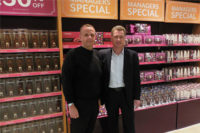Not every confectionery company can boast about its centennial heritage, much less do so while actively competing in today’s competitive confectionery climate.
As Jonathan Cockroft, the international director of the $400-million, UK-based company explained to the 15 executives attending Candy Industry’s 16th Annual European Suppliers Roundtable, two critical elements have changed for the company since Joseph William Thornton established his candy shop in Sheffield, England, in 1911.
First, the company is no longer a family-owner operation; it went public several decades ago in 1987, which brings its own challenges. And second, “High Street” or as Americans refer to it, Main Street, has changed.
“So, as we all are aware, the landscape of the typical High Street has changed almost out of all recognition within our lifetimes,” Cockroft told the group. “And with Thorntons being a shop owner, we prided ourselves on having a shop on every High Street of every town, at one point reaching 600 stores.
“The problem with that is — it’s a fantastic presence; it’s a fantastic shop window; it’s a brilliant way of getting very close to your customers,” he continued. “The difficulty is that High Street migrates — the center of gravity migrates — and, of course, with what the supermarkets have succeeded in doing in the last 30 years, a lot of that migration has moved away from downtown to out of town. So, if you’re a shopkeeper, that’s very difficult; you have a decision to make. You either stay where you are and accept that your footfall is less, or you pick up and you move with that center of gravity, which brings other difficulties. Now you have to find locations, you have to sell, you have to buy, you have to negotiate leases, and that all gets quite difficult if you’ve got 600 stores”
For Thorntons, the solution was to go where the retailers where — but instead of additional stores the company shifted focus to a branded product line.
“Until 12, 13 years ago, the only place that you could find our products was in our own shops,” Cockroft explained.
The decision proved challenging given the fact that as the international director pointed out, “When you start trading with the retailers, you lose control of price points, you end up promoting, and the environment is arguably not as prestige-like in an average supermarket as it might be in one of your own stores. Within your own stores, you can charge the price that you’re in control of.”
Fortunately, Thornton’s brand awareness in the UK is 95 percent. Its two main brands, Continental and Toffee, account for nearly 40 percent of all products sold and remain truly British icons.
Moreover, as Cockroft continued, “Our brand essence is actually not so much about chocolate as it is about thoughtful gifting. So, we don’t regard ourselves as playing in the confectionery industry so much as the gifting industry. So, the confectionery industry is at £3 or £4 billion; the gifting industry, 10 times that. So, we regard our competitive set as flowers, for example, and other things that you might give as gifts. That’s our marketing strategy.”
Given that philosophy, seasonal sales play a critical role in generating sales for the company.
“The seasonal area is an area that Thorntons has really grown to own — not own entirely, but certainly be a major player in,” he said. “So, for our customers in our shops and for those big retailers, this is an area where we’ve been particularly exciting and innovative.”
Cockroft then passed along examples of highly detailed, moulded chocolate products applicable for various seasons— from large Easter eggs to Santas — to the executives at the table.
“Our moulding ability is one of the things that we’re most proud of, along with our inlaid boxed chocolates,” he explained. The fact that the company has a state-of-the art manufacturing facility capable of producing such highly detailed chocolate moulds at high speeds provides it with a competitive advantage.
In addition to expanding its capabilities in the seasonal area, the company has targeted international markets, specifically North America.
“We’ve really only been playing in North America for quite a short period of time – less than three years,” Cockroft noted. “But we’ve done a lot of work with the retail trade and we’re focusing on about 20 different products in North America. And what we’re famous for are those seasonal moulds as well as our Continental brand of boxed chocolates”.
What Cockroft sees as another advantage for Thorntons, and specifically in the United States, is the fact that the company’s products are made of real chocolate.
“Britain is associated with quality,” he said. “That’s particularly true when you go over to North America. So we’ve just had a very exciting Christmas. Moreover, in North America, you find that the market is much more a bagged market — block-bottom bags, standup pouches. This enables you to hit certain price points as opposed to boxed chocolates.”
As a result, the company took that insight and rolled out one of its brands and launched it successfully in a block-bottom-bag format. It was just a matter of customizing the product line to an American audience, Cockroft explained.
Currently, Thorntons’ international business comprises less than 10 percent of total revenues. But as he points out, based on the kind of products the company is known for — gourmet, innovative and premium — he sees that growing to 20-25 percent within five years.
See also: 16th Annual European Suppliers Roundtable








